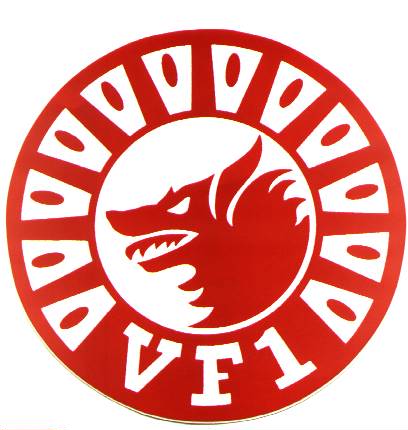

VF-1 Insignia Courtesy of Darryl Shaw |
Listing of F-14's Assigned to VF-1
Established on the 14th of October 1972 at NAS Miramar, at the same
time as VF-2, the squadron received it's first F-14As on 1st July 1973.
Squadron markings take the form of a stylised wolf's head, either red
(for the CAG and boss bird) or low vis grey.
The squadron made the first Tomcat cruise on USS Enterprise (CVN-65)
from September 1974. The end of this cruise saw the Tomcat's conflict
debut, as VF-1 and VF-2 flew air patrols over Saigon in April 1975 to
cover the final evacuation of US personnel.
During 1976 and 1977 VF-1 (along with VF-2) took part in trials of
prospective new camouflage schemes for the Tomcat. While I am unsure
as to how many aircraft were actually repainted, one I definitely know
about is BuNo. 158979, at the time VF-1's CAG bird. The scheme was
devised by aviation artist Keith Ferris in an attempt to break up the
aircraft outline. Due to it's look it became known as "splinter" scheme.
While it was originally intended to make the aircraft less visible, I
believe that trials showed it to have the opposite effect, the sharp
edges and high contrast in the pattern actually making aircraft more
visible! The colours used were dark grey, FS36118, on the top and
tails, with a medium grey, FS36231, on the top and bottom surfaces.
The remainder of the aircraft, the sides and areas of top and bottom,
were painted in a mix of light grey, FS16440 (90%), and white,
FS17875 (10%). An image of the colour scheme can be seen below.
 |
 |
 |
| VF-1 CAG bird for CVW-14 assigned to the USS Enterprise (CVN-65) in the late 70s. |
[Main Page] [F-14A] [F-14B] [F-14D] [Tomcat 21] [Atlantic Fleet Squadron Histories] [Pacific Fleet Squadron Histories] [F-14A Images] [F-14B Images] [F-14D Images] [F-14 Model Kits] [US Navy Air Wings] [A-6 images]